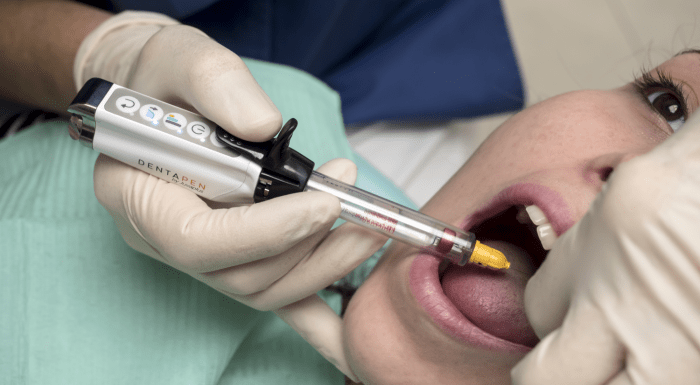Bibliography / Other References
1. Kleinknecht RA, Klepac RK, Alexander LD. Origins and characteristics of fear of dentistry. J Am Dent Assoc. 1973;
2. Milgrom P, Mancl L, King B, Weinstein P. Origins of childhood dental fear. Behav Res Ther. 1995;
3. Malamed SF. Local anesthesia. J Calif Dent Assoc. 1998;
4. Saloum FS, Baumgartner JC, Marshall G, Tinkle J. A clinical comparison of pain perception to the Wand and a traditional syringe. Oral Surg Oral Med Oral Pathol Oral Radiol Endod. 2000;
5. Hochman M, Chiarello D, Hochman CB, Lopatkin R, Pergola S. Computerized local anesthetic delivery vs. traditional syringe technique. Subjective pain response. N Y State Dent J. 1997;
6. Feda M, Al Amoudi N, Sharaf A, Hanno A, Farsi N, Masoud I, et al. A comparative study of children’s pain reactions and perceptions to AMSA injection using CCLAD versus traditional injections. J Clin Pediatr Dent. 2010;
7. Thoppe-Dhamodhara YK, Asokan S, John BJ, Pollachi-Ramakrishnan G, Ramachandran P, Vilvanathan P. Cartridge syringe vs computer controlled local anesthetic delivery system: Pain related behaviour over two sequential visits – a randomized controlled trial. J Clin Exp Dent. 2015;
8. Mittal M, Kumar A, Srivastava D, Sharma P, Sharma S. Pain Perception: Computerized versus Traditional Local Anesthesia in Pediatric Patients. J Clin Pediatr Dent. 2015;
9. Langthasa M, Yeluri R, Jain AA, Munshi AK. Comparison of the pain perception in children using comfort control syringe and a conventional injection technique during pediatric dental procedures. J Indian Soc Pedod Prev Dent. 2012;
10. Baghlaf K, Alamoudi N, Elashiry E, Farsi N, El Derwi DA, Abdullah AM. The pain-related behavior and pain perception associated with computerized anesthesia in pulpotomies of mandibular primary molars: A randomized controlled trial. Quintessence Int. 2015;
11. Alamoudi NM, Baghlaf KK, Elashiry EA, Farsi NM, El Derwi DA, Bayoumi AM. The effectiveness of computerized anesthesia in primary mandibular molar pulpotomy: A randomized controlled trial. Quintessence Int. 2016;
12. Kandiah P, Tahmassebi JF. Comparing the onset of maxillary infiltration local anaesthesia and pain experience using the conventional technique vs. the Wand in children. Br Dent J. 2012;
13. Tahmassebi JF, Nikolaou M, Duggal MS. A comparison of pain and anxiety associated with the administration of maxillary local analgesia with Wand and conventional technique. Eur Arch Paediatr Dent. 2009;
14. Versloot J, Veerkamp JS, Hoogstraten J. Pain behaviour and distress in children during two sequential dental visits: comparing a computerised anaesthesia delivery system and a traditional syringe. Br Dent J. 2008;
15. Al Amoudi N, Feda M, Sharaf A, Hanno A, Farsi N. Assessment of the anesthetic effectiveness of anterior and middle superior alveolar injection using a computerized device versus traditional technique in children. J Clin Pediatr Dent. 2008;
16. Klein U, Hunzeker C, Hutfless S, Galloway A. Quality of anesthesia for the maxillary primary anterior segment in pediatric patients: comparison of the P-ASA nerve block using CompuMed delivery system vs traditional supraperiosteal injections. J Dent Child (Chic) 2005;
17. Palm AM, Kirkegaard U, Poulsen S. The wand versus traditional injection for mandibular nerve block in children and adolescents: perceived pain and time of onset. Pediatr Dent. 2004;
18. Ram D, Peretz B. The assessment of pain sensation during local anesthesia using a computerized local anesthesia (Wand) and a conventional syringe. J Dent Child (Chic) 2003;
19. Kammerer PW, Schiegnitz E, von Haussen T, Shabazfar N, Kämmerer P, Willershausen B, et al. Clinical efficacy of a computerised device (STA) and a pressure syringe (VarioJect INTRA) for intraligamentary anaesthesia. Eur J Dent Educ. 2015;
20. Singh S, Garg A. Comparison of the pain levels of computer controlled and conventional anesthesia techniques in supraperiosteal injections: a randomized controlled clinical trial. Acta Odontol Scand. 2013;
21. Chang H, Noh J, Lee J, Kim S, Koo KT, Kim TI, et al. Relief of Injection Pain During the Delivery of Local Anesthesia by Computer-Controlled Anesthetic Delivery System for Periodontal Surgery: Randomised Clinical Controlled Trial. J Periodontol. 2016;
22. Beneito-Brotons R, Penarrocha-Oltra D, Ata-Ali J, Penarrocha M. Intraosseous anesthesia with solution injection controlled by a computerized system versus conventional oral anesthesia: a preliminary study. Med Oral Patol Oral Cir Bucal. 2012;
23. Lee S, Reader A, Nusstein J, Beck M, Weaver J. Anesthetic efficacy of the anterior middle superior alveolar (AMSA) injection. Anesth Prog. 2004;
24. Loomer PM, Perry DA. Computer-controlled delivery versus syringe delivery of local anesthetic injections for therapeutic scaling and root planing. J Am Dent Assoc. 2004;
25. Shah M, Shivaswamy S, Jain S, Tambwekar S. A clinical comparison of pain perception and extent of area anesthetized by Wand ((R)) and a traditional syringe. J Indian Soc Periodontol. 2012;
26. Özer S, Yaltirik M, Kirli I, Yargic I. A comparative evaluation of pain and anxiety levels in 2 different anesthesia techniques: locoregional anesthesia using conventional syringe versus intraosseous anesthesia using a computer-controlled system (Quicksleeper) Oral Surg Oral Med Oral Pathol Oral Radiol. 2012;
27. Yenisey M. Comparison of the pain levels of computercontrolled and conventional anesthesia techniques in prosthodontic treatment. J Appl Oral Sci. 2009;
28. Yesilyurt C, Bulut G, Tasdemir T. Pain perception during inferior alveolar injection administered with the Wand or conventional syringe. Br Dent J. 2008;
29. Sumer M, Misir F, Koyuturk AE. Comparison of the Wand with a conventional technique. Oral Surg Oral Med Oral Pathol Oral Radiol Endod. 2006;
30. Nusstein J, Lee S, Reader A, Beck M, Weaver J. Injection pain and postinjection pain of the anterior middle superior alveolar injection administered with the Wand or conventional syringe. Oral Surg Oral Med Oral Pathol Oral Radiol Endod. 2004;
31. Rosenberg ES. A computer-controlled anesthetic delivery system in a periodontal practice: patient satisfaction and acceptance. J Esthet Restor Dent. 2002;
32. Fernández-Castellano, E.R.; Blanco-Antona, L.A.; Vicente-Galindo, P.; Amor-Esteban, V.; Flores-Fraile, J. Pain Experienced during Various Dental Procedures: Clinical Trial Comparing the Use of Traditional Syringes with the Controlled-Flow Delivery Dentapen® Technique. Medicina. 2021.
33. O’Neal, L. Y., Nusstein, J., Drum, M., Fowler, S., Reader, A., & Ni, A. Comparison of Maxillary Lateral Incisor Infiltration Pain Using the Dentapen and a Traditional Syringe: A Prospective Randomized Study. Journal of endodontics. 2022.






